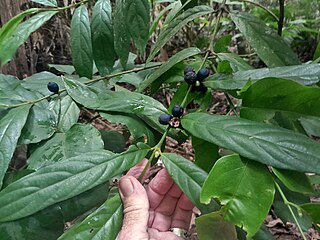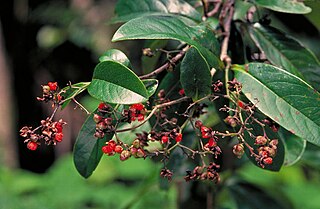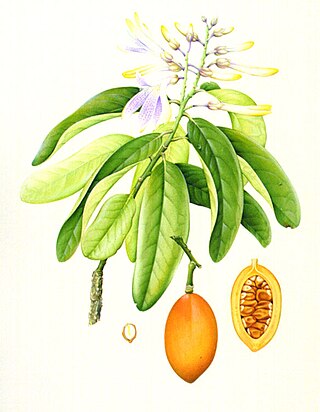
Alpinia caerulea, commonly known as native ginger or Australian ginger, is an understorey perennial herb in the family Zingiberaceae which grows in rainforest, gallery forest and wet sclerophyll forest in eastern Australia.

Dillenia alata, commonly known as red beech, golden guinea flower or golden guinea tree, is a tree in the Dilleniaceae family, found in tropical forests of the Moluccas, New Guinea, and northern Australia.

Syzygium forte, commonly known as flaky-barked satinash, white apple or brown satinash, is a tree in the family Myrtaceae native to New Guinea and northern Australia.

Gardenia actinocarpa is a rare and endangered plant in the coffee and gardenia family Rubiaceae, native to a very restricted area within the Wet Tropics rainforest of northeastern Queensland.

Hypserpa laurina is a slender twining climber in the plant family Menispermaceae. It is native to New Guinea and northeastern Queensland in Australia.

Harpullia ramiflora, commonly known as the Claudie tulipwood or Cape York tulipwood, is a tree in the Sapindaceae family native to north east Queensland, New Guinea and parts of Malesia.

Alpinia arctiflora, commonly known as the pleated ginger, is a plant in the ginger family Zingiberaceae which is endemic to northeastern Queensland.

Cleistanthus apodus, commonly known as the weeping Cleistanthus, is a tree in the family Phyllanthaceae native to New Guinea and northeast Queensland. It was first described in 1873 by the English botanist George Bentham in his seven-volume book Flora Australiensis.

Pandanus solms-laubachii, commonly known as the swamp pandan, is a small tree in the family Pandanaceae which occurs in northeastern Queensland and possibly in Papua New Guinea. It is closely related to both Pandanus gemmifer and Pandanus grayorum.

Lasianthus chlorocarpus, commonly known as blue rubi, is a plant in the family Rubiaceae native to parts of Malesia, Papuasia and Australia. It is an evergreen shrub growing up to 2 m high in well developed rainforest.

Atractocarpus sessilis, commonly known as brown randia, is an evergreen shrub in the family Rubiaceae. It is native to both Queensland, Australia, and Papua New Guinea (PNG).

Sterculia shillinglawii, commonly known as tulip sterculia or lacewood, is a tree in the cotton and cocoa family Malvaceae, native to Papuasia and northeastern Australia.

Tetracera daemeliana, commonly known as large-leaved fire vine, is a vine in the guinea flower family Dilleniaceae first described in 1886, which is endemic to the northern half of Queensland, Australia. The flowers are pleasantly perfumed.

Syzygium puberulum, commonly known as white satinash or downy satinash, is a plant in the family Myrtaceae which is native to rainforests of Cape York Peninsula, Queensland, and Papua New Guinea. It was first described in 1942.

Cupaniopsis flagelliformis, commonly known as brown tuckeroo or weeping flower tamarind, is a tree in the lychee, guaraná and maple family Sapindaceae which is endemic to eastern Australia. It is a small tree that inhabits drier or seasonal rainforests.
Aglaia cooperae, commonly known as Cooper's aglaia, is a small tree growing to about 4–6 m (13–20 ft) tall in the mahogany family Meliaceae. Twigs, leaves, leaf stalks, flowering and fruiting structures, the outside surfaces of the petals, calices and fruit are all covered in a dense reddish brown indumentum.

Mackinlaya confusa is a plant in the carrot, fennel and parsley family Apiaceae that is endemic to Queensland, Australia. It was first described in 1909.

Xanthophyllum fragrans, commonly known as fragrant boxwood, is an evergreen plant in the family Polygalaceae found only in the Wet Tropics bioregion of Queensland, Australia.

Cupaniopsis foveolata, commonly known as narrow-leaved tuckeroo, white tamarind or toothed tuckeroo, is a plant in the maple and lychee family Sapindaceae found in eastern Queensland and New South Wales, Australia.

Alpinia hylandii is a plant in the ginger family Zingiberaceae endemic to Queensland, Australia. It is a herbaceous shrub which grows to about 1 m high, and like many other gingers the true stems are underground and only the branches appear above ground. It has glossy leaves up to 16 cm long by 2.5 cm wide. Colourful pink and yellow flowers are produced in clusters at the ends of the branches, and are followed by globose, blue, capsular fruit containing numerous seeds.





















